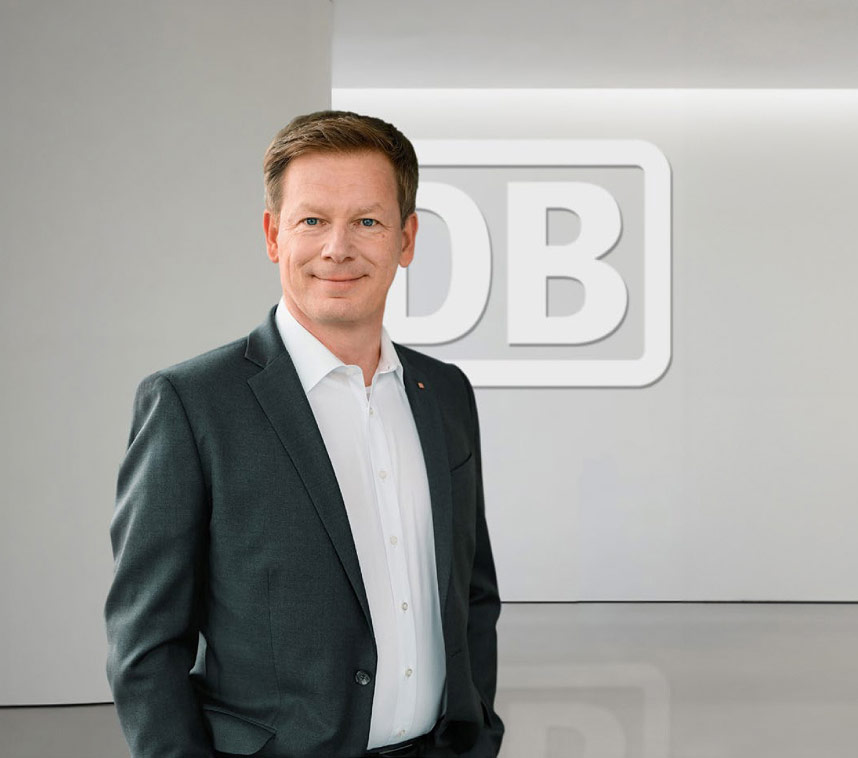
Chairman’s letter
Dr. Richard Lutz
CEO and Chairman of the Management Board
of Deutsche Bahn AG
Dear readers,
We are implementing our S3 restructuring program at full speed. Until the end of 2027, we will fundamentally improve DB Group’s profitability, infrastructure and operations. In the first half of 2025, we made significant progress in terms of profitability in particular. In infrastructure, we have brought a consistently high volume of construction onto the rail network. The operational challenges remain considerable.
DB Group is now on a much more stable footing economically than at the beginning of the year. We were able to significantly increase our adjusted EBIT in the first half of 2025 by almost one billion euros compared to the first six months of 2024. We have thus reduced our operating loss to minus 239 million euros. For 2025 as a whole, we aim to get out of the red and return to profitability.
In addition to the positive effects of, among other things, increased Government funds for infrastructure, one of the main reasons for the significant improvement is strict cost discipline throughout DB Group. This has enabled the train operating companies to compensate for the pressure on revenue development due to weak operational quality through their own efforts, thereby making significant advances in terms of EBIT.
At the same time, we are making good progress in streamlining administration and sales functions and exceeded our target as of June 30, 2025. Step by step, we are working more efficiently and more profitably.
We are pressing ahead with our recruitment offensive in operational professions such as in interlockings, trains and rail construction, and we aim to bring more than 20,000 employees on board this year, including about 5,700 young talents in Germany.
In the infrastructure pillar, we are making every effort to advance the modernization of the network and stations. We are managing to get the huge volume of construction work we have planned onto the rail network. Where modernization work is complete, we are seeing clearly positive effects as a result: on the generally modernized line between Frankfurt am Main and Mannheim, the network condition grade in punctuality-relevant crafts has improved significantly from 4.2 to 1.5. Infrastructure-related disruptions have fallen by 60 percent – with positive effects on punctuality in regional and long-distance transport.
The immensely high construction volume that is urgently required is affecting a large number of long-distance, regional and freight trains. Added to this is the persistently poor condition of many facilities. Despite this, we improved our punctuality in long-distance transport compared to the first half of 2024, although we fell just short of our target of at least 65 percent. For the year as a whole, we are reiterating our target of achieving punctuality of at least 65 percent in long-distance transport.
On the positive side, passengers are remaining loyal to rail. The customer satisfaction grade in long-distance transport has improved slightly from 2.7 to 2.5, mainly thanks to the outstanding commitment of all colleagues. Demand has increased compared to the first half of 2024. Never before have passengers traveled as many kilometers on our long-distance trains as in the first six months of 2025. The volume sold rose to a new record level and was more than five percent higher between January and June than in the same period of 2024.
This intact demand underlines the need for us to press ahead with our restructuring course with determination, as this is the only way we will be able to return to profitability in 2025. We are therefore actively working on additional efficiency and productivity improvements in administration, at our internal service providers and our train operating companies.
The Federal Government’s budget decisions for the years 2025 and 2026 are providing a strong tailwind for rail. Over the next two years, more money than ever before will flow into the rail infrastructure. From 2027 these funds will not continue to increase but rather will fall slightly. We will need to close this gap in funding if we want to implement the program for the rail infrastructure in Germany that we have developed in close cooperation with the Federal Government and the industry. We will campaign intensively for this.
One thing is certain: ultimately, it is the Federal Government and parliament that determine how much money should be invested into the rail system in Germany, thereby significantly influencing the further development of the capacity, stability and quality of the rail infrastructure. In any case, we will concentrate fully on the next steps and implement our S3 restructuring program in a disciplined manner and on the basis of clearly defined key figures.
Developments in the first half of 2025 have shown: that is the right approach, and there is no alternative. We remain committed to our goals. Because this is the only way we can make our contribution to a functioning everyday life for people and to a strong economy!
Sincerely

Dr. Richard Lutz
CEO and Chairman of the Management Board of Deutsche Bahn AG